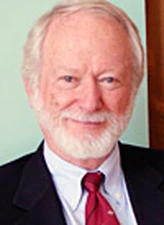Richard J. O'Connell

The 2008 Augustus Love Medal is awarded to Richard J. O'Connell for his fundamental and enduring contributions to geodynamics through studies of post-glacial rebound, mantle convection, Earth rotation and the properties of composite and cracked solids.
Early on in his career, in a series of papers dealing with post-glacial rebound that is widely accepted as being the first ‘modern’ analysis of this classic problem, Prof O’Connell demonstrated that the lower mantle is not ‘rigid’, as had been proposed by others, but that it has a viscosity low enough to permit mantle flow. This view of a ‘dynamic lower mantle’ has had an enormous impact on all aspects of global geodynamics (tectonics, rotation, etc.) and remains a standard paradigm of modern global geophysical research.
Following this early insight on lower mantle rheology, Prof. O’Connell made seminal contributions to elucidate the nature of the driving forces responsible for plate motions. To list some of his major achievements: He pioneered calculations of three-dimensional flow in a spherical geometry; he demonstrated that density contrasts in plates and slabs can drive surface plate motions in the case of ‘weak’ plate-boundary faults; he was the first to recognize and model the equi-partitioning of poloidal and toroidal energy in plate motions – a now fundamental constraint on the present-day mantle-lithosphere system; he argued that the dip angles of subduction zones implied that upper mantle flow penetrated into the lower mantle. In fact, his championing of mantle-wide flow persisted through an era when it was a minority view and he was ultimately vindicated by seismic tomographic images which showed cold descending slabs moving inexorably into the lower mantle (e.g., under Tonga, Japan, etc.).
As if to balance his work on subduction dynamics, Prof. O’Connell has recently made a series of significant contributions to the study of ascending mantle flow; namely, upwelling plumes. Working with colleagues at Harvard he has shown that chemically-distinct plumes can remain un-mixed over age-of-the-Earth time scales. Furthermore, by modeling the interaction of plumes with mantle-wide flow, Prof. O’Connell and his colleagues provided a plausible explanation of features ranging from the distribution of plumes and hotspot tracks relative to ridges and subduction zones to the enigmatic bend in the Hawaiian-Emperor seamount chain. These studies have, once again, demonstrated the necessity of a global mantle flow context, even for so-called ‘regional’ surface features.
Prof. O’Connell also made noteworthy contributions in the areas of Earth rotation and material properties. Relatively early in his career, O’Connell showed that large earthquakes could excite the Earth’s Chandler wobble and the idea continues to motivate new studies. More recently he showed that mantle flow models are capable of reconciling long-term (107 – 108 year) wander of the rotation pole inferred from paleomagnetic observations. This work has been influential for two reasons. First, it demonstrated that mantle flow contributes significantly to present-day polar wander; hence efforts to constrain recent climate-induced changes in polar ice mass using the polar wander record must take this signal into account. Second, it has motivated numerous studies of long-term orbital and climate change induced by mantle flow. In regard to material properties, Prof. O’Connell is responsible for hallmark studies on the elastic and viscoelastic properties of composite (especially cracked and porous) materials. His studies have examined seismic velocities in these materials and they have significantly broadened our understanding of dissipation mechanisms. Prof O’Connell also examined physical conditions for the existence of partial melt within the upper mantle and the optimal geophysical tools for constraining melt reservoirs. The work has relevance in a huge variety of geological settings, as well as in the modeling of plate boundary processes, and it remains a key reference in the field.
Professor Richard O’Connell’s achievements have placed him at the forefront of geophysical research for three decades, and his career has been distinguished by seminal contributions to our understanding of mantle processes. He would be an impeccable choice for the Augustus Love Medal of the European Geosciences Union.
